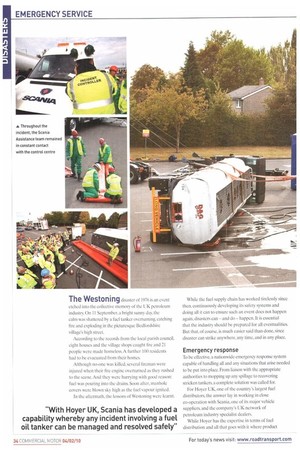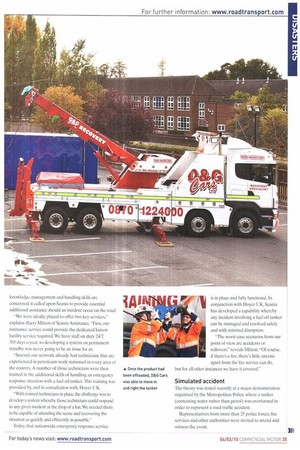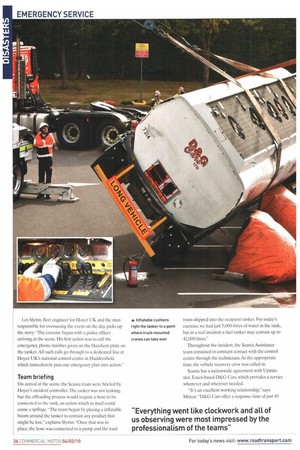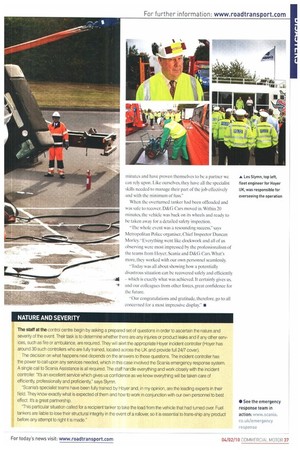The Westoning disaster of 1976 is an event etched into
Page 34

Page 35

Page 36

Page 37

If you've noticed an error in this article please click here to report it so we can fix it.
the collective memory of the UK petroleum industry. On 11 September. a bright sunny day. the calm was shattered by a fuel tanker overturning, catching fire and exploding in the picturesque Bedfordshire village's high street.
According to the records from the local parish council, eight houses and the village shops caught fire and 21 people were made homeless A further 100 residents had to be evacuated from their homes, Although no-one was killed, several fireman were injured when their fire engine overturned as they rushed to the scene. And they were hurrying with good reason: fuel was pouring into the drains. Soon after, manhole covers were blown sky high as the fuel vapour ignited.
In the aftermath. the lessons of Weston ing were learnt. While the fuel supply chain has worked tirelessly since then, continuously developing its safety systems and doing all it can to ensure such an event does not happen again, disasters can — and do — happen. It is essential that the industry should be prepared for all eventualities. But that, of course, is much easier said than done, since disaster can strike anywhere, any time, and in any place.
Emergency response
To be effective, a nationwide emergency response system capable of handling all and any situations that arise needed to be put into place. From liaison with the appropriate authorities to mopping up any spillage to recovering stricken tankers, a complete solution was called for.
For Hoyer UK, one of the country's largest fuel distributors, the answer lay in working in close co-operation with Scania, one of its major vehicle suppliers, and the company's UK network of petroleum industry specialist dealers.
While Hoyer has the expertise in terms of fuel distribution and all that goes with it where product knowledge, management and handling skills are concerned, it called upon Scania to provide essential additional assistance should an incident occur on the road.
"We were ideally placed to offer two key services," explains Barry Mitton of Scania Assistance."First, our assistance service could provide the dedicated liaison facility service required. We have staff on duty 24/7, 365 days a year, so developing a system on permanent standby was never going to be an issue for us.
"Second, our network already had technicians that are experienced in petroleum work stationed in every area of the country. A number of those technicians were then trained in the additional skills of handling an emergency response situation with a fuel oil tanker. This training was provided by, and in consultation with, Hoyer UK.
"With trained technicians in place, the challenge was to develop a system whereby those technicians could respond to any given incident at the drop of a hat.We needed them to be capable of attending the scene and recovering the situation as quickly and efficiently as possible."
'Foday, that nationwide emergency response service
is in place and fully functional. In conjunction with Hoyer UK, Scania has developed a capability whereby any incident involving a fuel oil tanker can he managed and resolved safely and with minimal disruption.
"The worst-case scenarios from our point of view are accidents or rollovers," reveals Mitton."Of course. if there's a fire, there's little anyone apart from the fire service can do. but for all other instances we have it covered."
Simulated accident 1 he theory was tested recently at a major demonstration organised by the Metropolitan Police, where a tanker (containing water rather than petrol.) was overturned in order to represent a road traffic accident.
Representatives from more than 25 police forces, fire services and other authorities were invited to attend and witness the event.
Les Slymn, fleet engineer for Hoyer UK and the man responsible for overseeing the event on the day, picks up the story: "The exercise began with a police officer arriving at the scene. His first action was to call the emergency phone number given on the Hazchem plate on the tanker. All such calls go through to a dedicated line at Hoyer UK's national control centre in Huddersfield, which immediately puts our emergency plan into action.
Team briefing
On arrival at the scene, the Scania team were briefed by Hoyer's incident controller. The tanker was not leaking, but the offloading process would require a hose to be connected to the tank, an action which in itself could cause a spillage. "The team began by placing a inflatable boom around the tanker to contain any product that might be lost: explains Slymn."Once that was in place, the hose was connected to a pump and the load
Inflatabte cushions trans-shipped into the recipient tanker. For today's right the tanker to a point exercise, we had just 5,000-litres of water in the tank, where truck-mounted but in a real incident a fuel tanker may contain up to cranes can take over 42,000 litres"
Throughout the incident, the Scania Assistance team remained in constant contact with the control centre through the technicians. At the appropriate time, the vehicle recovery crew was called in.
Scania has a nationwide agreement with Upminster, Essex-based D&G Cars, which provides a service whenever and wherever needed.
"It's an excellent working relationship," says Milton. -D&G Cars offer a response time of just 45 minutes and have proven themselves to be a partner we can rely upon. Like ourselves, they have all the specialist skills needed to manage their part of the job effectively and with the minimum of fuss."
When the overturned tanker had been offloaded and was safe to recover, D&G Cars moved in. Within 20 minutes, the vehicle was back on its wheels and ready to be taken away for a detailed safety inspection.
"The whole event was a resounding success," says Metropolitan Police organiser, Chief Inspector Duncan Morley. "Everything went like clockwork and all of us observing were most impressed by the professionalism of the teams from Hoyer, Scania and D&G Cars. What's more, they worked with our own personnel seamlessly.
"Today was all about showing how a potentially disastrous situation can be recovered safely and efficiently which is exactly what was achieved. It certainly gives us, and our colleagues from other forces, great confidence for the future.
"Our congratulations and gratitude, therefore, go to all concerned for a most impressive display." •




































































































































